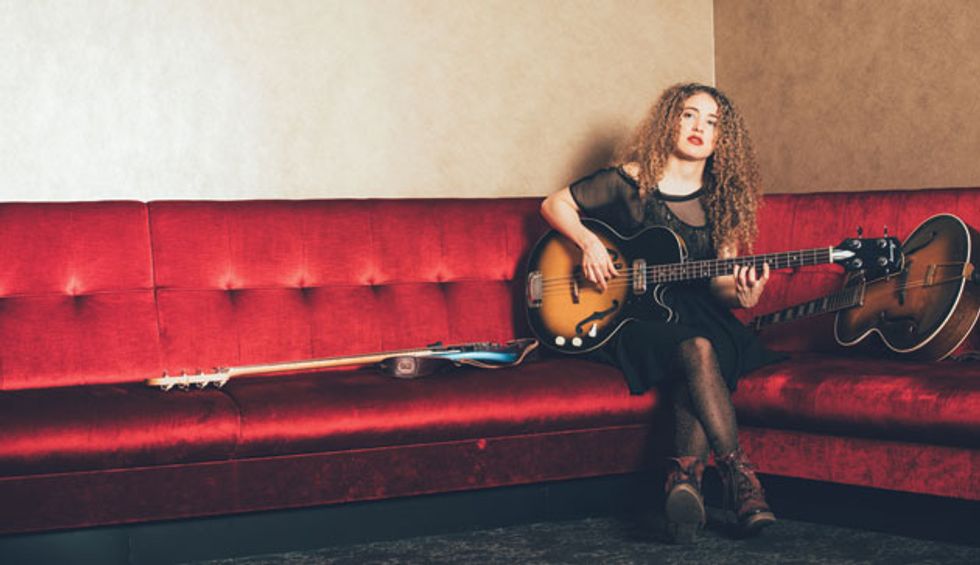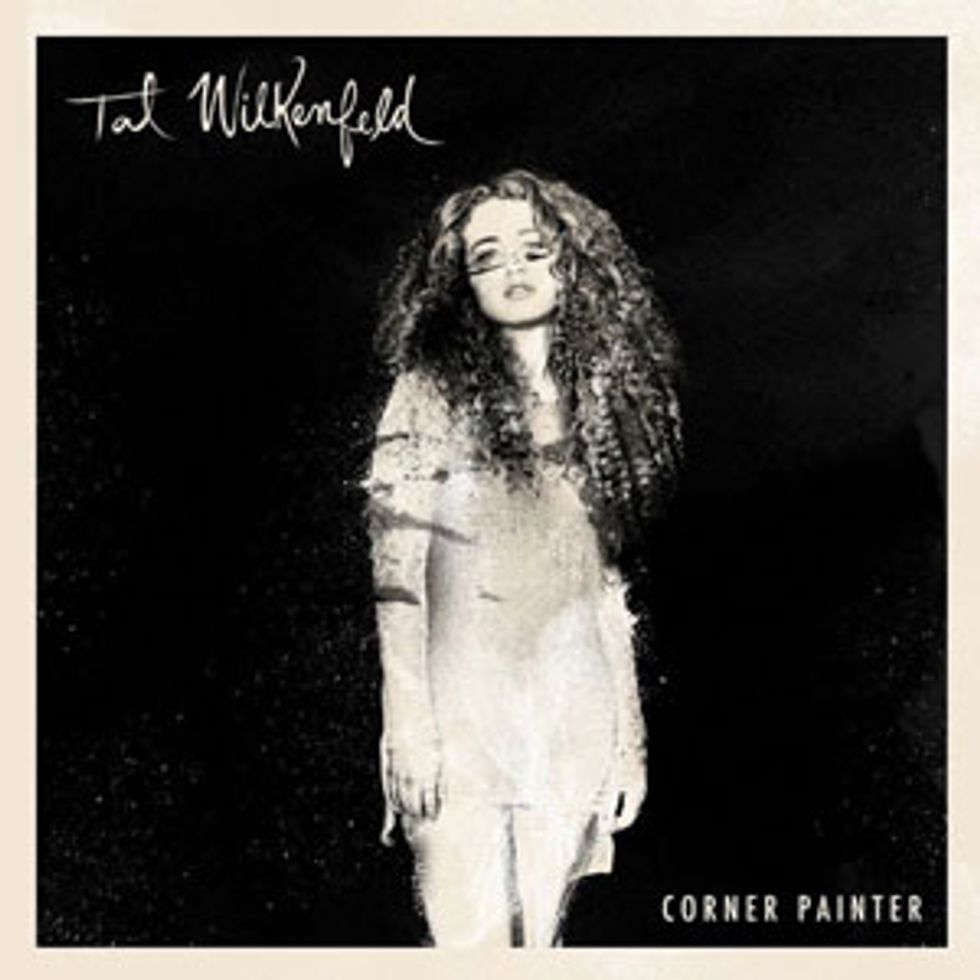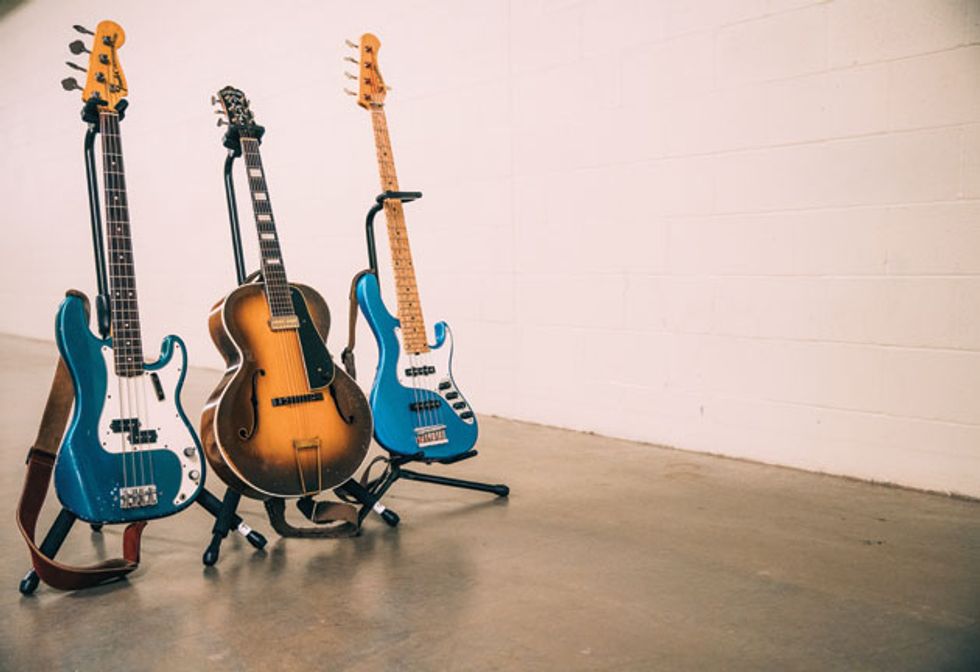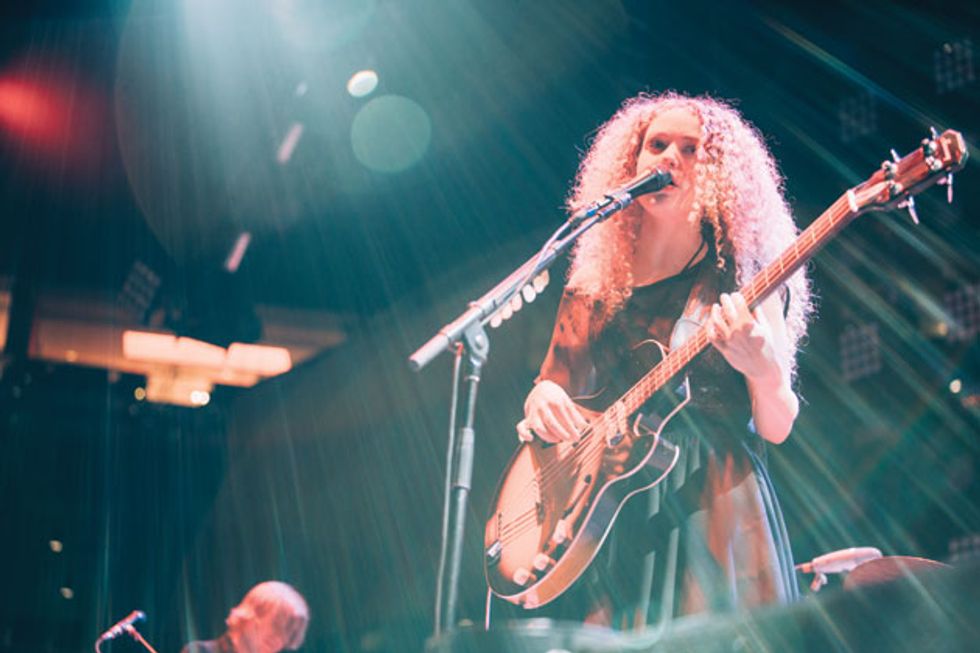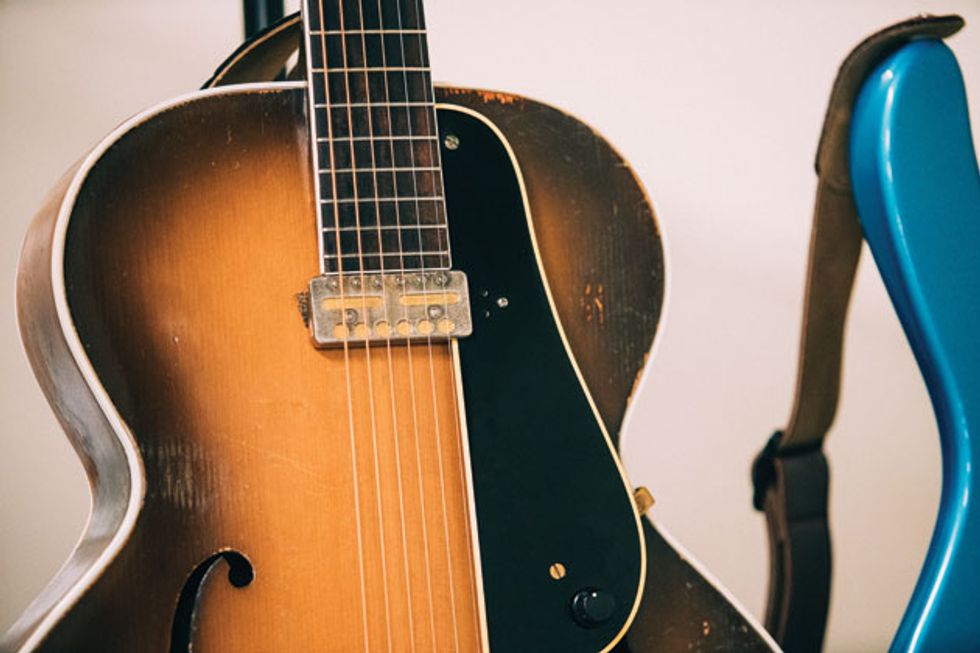As the dexterous bassist transitions from sideman to songwriter on her upcoming solo album, she’s adamant about being true to herself, her music, and her expression.
Tal Wilkenfeld’s upcoming as-yet-untitled solo album showcases her skills as a songwriter and vocalist. It also shifts the energy away from the bass—she’s playing guitar more live, especially baritone acoustic. Photo by Taylor Smith
If you’re reading this magazine, you probably know Tal Wilkenfeld as a fierce bassist—a consummate force to be reckoned with. A player so good that she performed with the Allman Brothers at age 20, and in that same year recorded her first album, Transformation, and was recruited to go on tour with Chick Corea. Soon after, she joined the live band of one of the most celebrated guitarists to this day: Jeff Beck. Her success wasn’t just a lucky bolt of lightning. Since then, the Australian-born low-ender has gone on to work with a five-star laundry list of who’s who in the world of music-making and shaking, from Herbie Hancock to Ryan Adams, Prince, and Pharrell. Her performance at Eric Clapton’s 2007 Crossroads Festival has generated millions of views on YouTube.
The proof is in the pudding, as they say.
You might not know that Wilkenfeld, now 29, started out on guitar, but, even more surprisingly, she nearly became a drummer before that. A year before she picked up her first guitar, she sat down at her best friend’s drum set at age 13 and went to town. (More on that later, but if you want to see her in action, there’s a recent video of her playing Ringo Starr’s drum set on her Facebook page.) She could probably play any instrument she wanted to, but the point is, when it comes to music, the woman has no fear.
Not to start a ruckus about the born-talent-versus-hard-work theory, but Wilkenfeld makes a case for the former. She says it wasn’t ever challenging for her to play with enlightened musical virtuosos who are at one with their instruments.
“Music for me is not a collection of intellectual data that I gathered over time,” Wilkenfeld told us in her Louisville, Kentucky, hotel room while on tour opening up for the Who. “For me, at least, I picked up the instrument and it became a form of creative expression. And then everything I thought or felt then came through music, and so then you get together with Jeff Beck or Herbie Hancock or whoever it is, and you have a conversation. It’s just a really seamless conversation when it’s with somebody as creatively unlimited as Herbie or Jeff. They’re free to express themselves the way they hear it in their head. And so it almost makes my job easier, not harder, to play with such amazing musicians. Because there’s no fight, there’s no struggle. If you add someone like Vinnie Colaiuta playing drums into the mix on top of that, that makes it even more painless, because he’s another musician who can just freely express himself without limitation.”
As for the catalyst that sparked her upcoming solo album, which marks both her vocal debut and her larger exposure to fans as a songwriter, Wilkenfeld says she’s written songs since she first picked up an instrument. “Maybe to some people this is kind of a strange or a far-fetched transition for me to come from being bass player with Jeff Beck and Herbie to being this songwriter singing songs,” she says. “But it feels very natural to me.”
By the same token, the overwhelming positive feedback on her solo performance of Leonard Cohen’s “Chelsea Hotel” on bass and vocals at the November 2013 Bass Player magazine awards ceremony in Los Angeles—where Wilkenfeld won the “Young Gun Award”—might’ve encouraged the haste to get her unheard songs out to the masses. After a video of that performance was posted a year later, it went viral and Wilkenfeld soon went into Hollywood’s EastWest Studios to start recording.
The sessions for her new as-yet-untitled album included big talent: Blake Mills, Benmont Tench (Tom Petty and the Heartbreakers), Sonya Kitchell, Jeremy Stacey (King Crimson), Paul Stacey (Black Crowes), Zac Rae (keyboardist on Cheap Trick’s new album). A PledgeMusic campaign is underway to finish mixing and mastering the collection of 10 or so recorded tracks, which Wilkenfeld says she wrote over the course of many years while on the road as a sideman for other musicians.
For her recent month-long opening slot with the Who on their late winter/early spring tour, she and her live band—drummer Tamir Barzilay, guitarist Owen Barry, and Chris Price on keys—carved out their own circuit of smaller club shows between big arena dates. After logging about 20 gigs, Wilkenfeld is currently gearing up to launch her new record this summer.
Wilkenfeld plays mostly bass and sings in her current live show, but she also plays acoustic on a few tunes, such as her first single, “Corner Painter.” The massive-sounding song has a serious rock edge and is a major departure from her 2007 instrumental debut; the most notable difference is the focus shift from showcasing her bass mastery.
In fact, there is no bass guitar on “Corner Painter”—Wilkenfeld plays the baritone acoustic guitar and recorded the bass parts on organ. The swells of guitar toward the song’s end are tastefully executed by Mills, interlocking with Wilkenfeld’s rhythm and moody, crystalline cadence. Her unique phrasing, writing ability, and sonic singularity recalls artists like Alanis Morissette and Sinead O’Connor.
The vibe is vulnerable in “Haunted Love” and “Under the Sun,” the latter of which begins with a remarkably emotive bass intro before Wilkenfeld’s poetic lyrics kick in. The track’s outro is a stellar combination of a melancholy bass solo punctuated with a stunning Arabic string melody that gives the tune a Far Eastern or Middle Eastern feel. Wilkenfeld pours herself fully into “Haunted Love”—it’s all her on just bass and vocals, a simultaneously soft and angelic yet obviously stormy ode to a lover.
To set the pace for her new batch of solo work, we asked Wilkenfeld if she considers herself serious or chilled out when making music. She kept it mysterious: “I can be all things depending on the situation.” All things considered, that seems about right.
The first time you strummed a guitar was at the age of 14. Do you remember where you were and what you were playing?
Yeah, it was at my school. There was a nylon-string acoustic there and I literally picked it up, played a chord, and started crying. I was overwhelmed, and then I started writing a song pretty much straight away.
Why did you switch to bass a few years later?
When I started, the first thing I did was write a song. That’s more of a supportive role in terms of the instrument to the voice. And then I started getting more interested in developing my skills as an instrumentalist, although even then I seemed to be more drawn to more rhythmic aspects of music. At any given opportunity I’d be running to the drum kit or the bass. I was always gravitating towards those instruments. After a while, people started telling me, “Hey, if you love the bass or the drums so much, you should just play the bass or the drums.” And I knew it, but it took me a minute to make the switch and I finally did when I was 17.
Why did you pick bass over drums?
[Laughs] It’s kind of a funny story. Before I ever started the guitar, one of my best female friends played the drums, and one day I decided to get on her drum kit. I suppose I could just play naturally and she got really upset and angry and said, “If you start playing the drums, I’ll never speak to you again.” And I’m like, “Oh, okay.” Our friendship was more important, I guess. Like a year later I ended up picking up the guitar. I don’t know why that then informed me as to not switch to the drums when I was 17, but I suppose I did like informing the harmony, and so I thought the bass was a great middle ground between drums and guitar.
Are you still friends with that drummer?
I’m not.
Tal Wilkenfeld’s main workhorse instruments for live shows include (from left to right) a Fender P-bass, a vintage 1950s Epiphone archtop given to her by previous owner Ben Harper, and a Sadowsky NYC 5-string tuned
E–A–D–G–C (low to high). Photo by Taylor Smith
The drums can be kind of intimidating, so it’s surprising that you picked it up so naturally.
I’m not intimidated…. I can’t really associate music with fear because it sort of works in opposition. Music is freeing; it’s a means to express your soul, so if you come at music with any type of fear, you won’t be able to fully express your soul. Fear just pulls you out of being true to music, which is coming from a place of love. Love is the opposite of fear. I stay away from anything fear-related.
You said you switched to bass at 17 because you were drawn to rhythm. Do you have any favorite rhythm guitar players?
When I was really young, I was introduced to Freddie Greene’s playing and I was influenced by that. I was listening to Jimi Hendrix, and when you listen to his guitar playing, it’s hard to differentiate—well, I wouldn’t want to differentiate between what I would consider rhythm guitar playing versus lead because he’s just accompanying himself in his unique way that he does. I was influenced by that and I was influenced by guitar playing on certain artists like Earth, Wind & Fire and Tower of Power, that kind of rhythm playing. Not necessarily from a guitar player’s point of view, but that groove-orientated music. That’s kind of it!
Did you have a musical family?
I didn’t grow up with much music around me; honestly it was quite the opposite. I didn’t necessarily know where my inspiration was coming from, because I only heard a handful of artists growing up. I wasn’t really exposed to much—I had to discover it for myself.
I want to be.”
How was the tour with the Who? Did you get to have any musical conversations or jams with Pete Townshend? I’m sad it’s over but it was good. I had a couple of very insightful musical conversations with Pete. He’s very wise and intelligent, as one would expect. It was an honor to spend time with him and pick his brain.
Why do you think you waited so long to put an album out since Transformation? How did you know you were ready to go into the studio?
These songs are a collection of thoughts and feelings and ideas from the last five or six years that have sort of arrived between or during various gigs that I’ve been doing as a sideman. It hasn’t come all in one short period of time.
I suppose there was not much thought behind it other than I had no intention to put something out on any specific date. I was just writing songs and collecting them and recording them when I could, between working and touring and recording with other people and whatnot.
This album isn’t your debut record, but it’s your vocal debut. Did you ever think of yourself as a singer?
I don’t think of myself as an “anythinger.” Therefore maybe I even shy away from calling myself a musician, because I’m just a human who’s using music as one of the means to express myself. I don’t really want to pigeonhole myself into being anything, even for the sake of the mind games that can happen internally if you start calling yourself something, you know?
Tal Wilkenfeld’s Gear
BassesSadowsky NYC 5-string (tuned E–A–D–G–C)
Fender Precision Bass
Harmony H22 Guitars
Gibson CF-100
Yamaha baritone acoustic 27" scale
Epiphone Broadway
1950s Epiphone archtop (previously owned by Ben Harper)
Amps
EBS HD350
EBS ProLine 410 4x10 cabinets (2)
Ampeg (various models)
Effects
Boss VB-2 Vibrato
TC Electronic Flashback Delay
TC Electronic Hall of Fame Reverb
EBS OctaBass
Way Huge Pork Loin overdrive
Peterson tuner
Strings and Picks
D’Addario EJ17 Phosphor Bronze Medium (.013–.056, Gibson CF-100)
D’Addario EJ16 Phosphor Bronze strings (.016p–.070w, Yamaha baritone acoustic)
D’Addario EFT16 Flat Top Phosphor Bronze (.012¬–.053, Epiphone Broadway)
What was the inspiration behind these songs?
I’ve been inspired by experiences that I’ve had. I’ve been inspired by hearing of my friends’ experiences and friends of friends’ experiences. I’ve been inspired by movies and all other kinds of platforms, what’s going on in the world. I couldn’t really point to any particular song and say it was clearly one inspiration. It’s usually a collection of things that inspires me to write.
When you’re writing, do you start with lyrics or music?
I actually don’t have a formula. Sometimes I wish I did, because it would make my life a lot easier. But it could start off with a lyric, it could start off with an instrument, it could start off with me just driving in the car and hearing something in my head. Poetry, words … sometimes even when I’m falling asleep something will come to me.
Were most of the songs written by you?
I co-wrote a few of the songs. Not “Corner Painter,” but I wrote a few songs on the record with a friend of mine named Sonya Kitchell.
Did Jackson Browne have any influence on this album?
I used his studio to do some stuff on the album. He’s definitely been a guiding force for me on the album and a great friend as well. We’ve done some appearances together. I did something with him and Ben Harper at one point. I’ve also done a gig with him where I played a few of my songs, and he played a few of his, and Blake Mills and Dawes played some songs and then we all played together. I forget what that was for. I think it was a benefit or something.
Jeff Beck called you a genius, which is a very high compliment. What does it feel like for someone at his level to say that about you?
I appreciate any accolades I’m given, but that word “genius” is a hard pill for me to swallow just because I have such high standards for myself in terms of where I see myself being creatively, or where I want to be.
Where do you want to be?
I couldn’t tell you what I want my music to sound like in words; that would be kind of awkward. I’m always reaching for a new height. I’m not ever going to stay in one place. I push to evolve, so any kind of a landing word like [genius].… I don’t want to feel like I’ve arrived at a place I need to stay at.
Do you see yourself following your own path with your band for a while or are you open to being a side player again?
I’m open to anything at all times. It’s just a matter of sectioning off time to do everything. Right at this very moment I’m focusing on this album because it’s yet to be released. Once it goes out to the world, there are a lot of things I want to do, including writing for film.
Wilkenfeld works her Harmony H22 4-string while opening for the Who in Louisville, Kentucky, on March 12, 2016.
Photo by Taylor Smith
How did you select your band for the sessions?
I’ve known Blake [Mills] for about seven years. I’ve known Jeremy Stacey, the drummer, for about 10 years. I’ve known Benmont [Tench] for seven years, maybe. It was trial and error going into the studio with different people and it seemed like that band fit that particular expression of composition the most.
How did you meet your touring guitarist, Owen Berry?
I met Owen through Jeff Beck about eight or nine years ago. Jeff was saying, “This guy is really great, you gotta check him out.” Tim Lefebvre, who plays with Derek and Susan, also told me about Owen. I had two people telling me to check him out, so I did.
Do you like to take musical risks?
Of course, yeah, that’s the only way. I like to fall on my ass frequently. [Laughs]
Is expression the same for you on all instruments that you play?
I would hope so. The more time you spend with the instrument, the less anything technical will get in your way of communicating what’s in your head. So I try to put time into the instruments I choose to play.
Would you say that you practice?
Currently no. When I first started, I tried to play an hour a day. Sometimes I would play a lot more than that. I used to play more back in the day.
What would you do for practice?
I would either compose music or I would practice playing what’s in my head and then I’d stumble on something I couldn’t quite articulate. Then I’d go back and try to play the thing that I stumbled on. Once I could play it, I’d move on to the next thing in my head that I would stumble on.
It’s sort of the same way as talking. You talk until you struggle to find a word and then you might have to stop that sentence in order to find the word or maybe you have to look it up, and then you say it, and the next time you come across that word you can probably just say it. It’s the same with music.
What tunings did you use on the album?
I used either standard, baritone standard, open major tunings, and standard with the lowest string dropped a whole step.
If your music had an odor, what would your new album smell like?
[Laughs] What’s the next question?
What advice would you give to young artists trying to find their voice?
To not try to find their voice, and to just express their voice.
Who else in your years since your breakout with Beck has influenced your playing or approach to music?
Lightnin’ Hopkins. Bob Dylan. Those are the main two. Lightnin’ Hopkins is one of my favorite guitarists. He’s got such a soulful and amazing groove and sense of musical expression.
YouTube It
Tal Wilkenfeld and her band perform a stripped-down version of “Corner Painter,” the first single off her upcoming album. Her acoustic rhythm played on a Yamaha baritone takes the spotlight and fills the room in this recent intimate rendition.
There’s no holding back for Tal Wilkenfeld on “Hard to Be Alone,” a new song revealing her strong vocal range live as she holds down the low end on her Fender P-bass. Skip to the outro around the 4-minute mark to hear some jaw-dropping, Linda Perry-like howls over guitarist Owen Barry’s formidable Tele licks.
Have the things you want to say as an artist changed over the years?
The one consistency in being an artist is knowing and being excited by the fact that I’m always changing, and hopefully for the better! [Laughs]
Fusion: What does that word mean to you in relation to your own music?
I use the word fusion to describe any combination of styles—food, music, etc. However, I’m very aware that the term “fusion” is more often used to describe jazz, rock, and funk combinations, and more often than not, instrumental. Not sure why such a broad term was prescribed for such a specific style, but there you have it. I don’t consider my new music to be the latter description of fusion, but definitely the former.
What do you think makes for exciting guitar or bass playing?
Someone being true to themselves and true to a song.
You look really happy when you’re playing. What does it feel like when you’re performing live?
It feels like I’m being true to myself.
Photo by Taylor Smith
Pay It Forward: A Tale of Guitarma
The 1950s Epiphone archtop guitar Tal Wilkenfeld is holding on the cover of this issue of PG, shown up close here, is a vintage, oddball 6-string. The journey it took to get into Wilkenfeld’s arms is quite an interesting backstory. Ben Harper told PG the tale while backstage before his recent show at Chicago’s Riviera Theatre. It turns out the guitar had been around Harper’s family music shop, now the Folk Music Center in Claremont, California, for a while. Luthier Jack Willock (who worked for Gibson in the late 1930s and ’40s and who Harper apprenticed with from 1989-1993) restored it, but the Teisco gold foil pickup was already in place. According to Harper, it was likely installed in the early ’80s by someone with an affinity for Ry Cooder.Harper was clearing out some inventory from his warehouse and took the guitar to a local music store to sell on consignment. Unbeknownst to Harper, Wilkenfeld saw the guitar in the shop and fell in love. And unbeknownst to her, it belonged to her friend, Harper. After a few months, the guitar hadn’t sold so Harper took it back and put it on eBay.
In the meantime, Wilkenfeld returned to the store to find the guitar missing and begged the staff to tell her who the owner was. When she found out it was Harper’s guitar, she contacted him to profess her adoration for the guitar and to see if he still had it so she could buy it.
Just days prior, Harper had shipped the guitar to a buyer who purchased it on eBay. Harper contacted the buyer to plead his case that a dear friend had become attached to the guitar. He offered the buyer (who didn’t know the seller was Ben Harper) to buy it back at a premium. The buyer agreed, the guitar was returned, and Harper gave the guitar to Wilkenfeld. Sidenote: A few weeks later, the buyer emailed Harper to let him know he found the exact model elsewhere in mint condition. A story with a happy ending!
Harper says he and Jackson Browne have a word for this: “Guitarma.”
